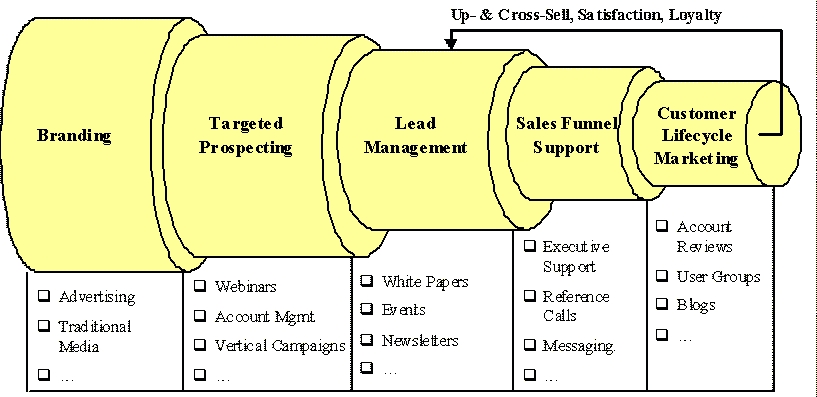The sales funnel (or pipeline) is a well-known graphic as well as diagnostic tool. It depicts the sales process and its attendant sales stages, and it is especially common in the business-to-business (B2B) world with its typically longer sales cycles and numerous decision makers. Every funnel has certain elements in common, with a wide opening at the top (many prospects) and narrow opening at the tip (closed deals).
The marketing funnel (see figure above) works on the same principle as the sales funnel. There is a large opening at the beginning (large awareness pool) and a winnowing or funneling down at the end (customer list).
(In fact, the underlying theme of most successful businesses is one of segmentation, focus and targeting. Hence, most businesses are a sort of funnel, as they vet and qualify the segments they will target and the offerings they will launch. There is an innate winnowing process, as there is more opportunity than one person, one department or one business can profitably and successfully pursue.)
One model of the marketing funnel in the B2B world starts with branding, and then builds awareness and interest, targeted prospecting, lead management, sales funnel support and, finally, customer lifecycle marketing.
Branding
The top (or left, as above) of the marketing funnel is focused on branding and the building of awareness and favorable associations. Given the voluminous literature around branding, I won't attempt to cover more than a thumbnail sketch. Suffice it to say, however, that the ultimate arbiter of whether you are "walking the talk" in terms of your brand promise is the customer.
The branding stage could be defined as the art and science of creating an association or nexus in the mind of a potential buyer, highlighting your offer and/or company and a desired characteristic (such as quality, dependability, good value, and so on). Activities in this stage may include general advertising through traditional media (mass media buys, publicity and buzz campaigns, etc.) and seminars for large segments (targeting the manufacturing industry, for example) or for key decision makers (CIO, VP of sales, and so on).
The main message here is that you need a lot of impressions to create an imprint on the market's psychic awareness as well as to begin to fill the marketing funnel. Depending on how fragmented and competitive the market is, you may only get 1-5% in terms of qualified leads out of such activities.
Building brand equity, however, takes time; the results may not manifest themselves for months or years. Many companies in the B2B space usually don't notice the adverse impacts of less marketing until 6-9 months after the initial budget cuts, when it's often too late to fully recover.
Targeted Prospecting
This funnel stage is where you've winnowed down the focus to your target markets and accounts. It is a process of identifying, analyzing and educating the key decision makers in the targeted markets/accounts.
It's surprising how often salespeople pursue opportunities outside their chosen targets (and sales managers let them), and win few of them. Brand-building and awareness campaigns at the top of the funnel will help the prospect education process in this stage. As Harry Beckwith writes in What Clients Love, "Advertising [one vehicle for branding] warms every marketing and sales effort that follows it."
Activities in this stage may include targeted webinars, account management, mapping any unpenetrated opportunity and specific vertical campaigns. The main focus here is to allocate resources to the specific targets where your company can add value, offer up a solution and can extract a profit.
Lead Management
A lead is generally defined as someone who shows an interest, through various means, in a company's offerings, although it's often defined differently depending on the organization. The key is to have a fairly granular definition that everyone agrees with. A lead could be generated from seminars, advertising, account mapping or Web sites, among other myriad marketing or sales vehicles.
Generating, vetting and distributing leads involves numerous processes and coordination efforts. Various studies show that most marketing leads, especially in the B2B space, are not followed up on by salespeople or fully audited by management.
In general, if weak or unqualified leads are continually distributed to the sales organization, salespeople are less likely to give them much attention going forward. For example, in a 2003 META Group report titled "Lead Management: The Hinge Between Marketing and Sales," the authors write that "many Global 3000 organizations report that 70 to 90-plus percent of marketing-generated leads are not acted on, because sales finds them unqualified (an often-provided excuse for not making sales projections)."
If it's worth the effort to try to generate leads, it's worth the time to follow up in a timely manner. Also, if you don't track the lead source, it's next to impossible to determine what's working. As outlined in a recent MarketingProfs article, marketing ROI is often dependent on the value created from lead management activities.
In terms of lead metrics, for example, cost per lead is meaningless if most of the leads are unworthy of pursuit and never end up as closed deals (the quantity vs. quality problem). Cost per opportunity or closed deal may be a better measure.
If your conversion rate is much higher using certain lead development campaigns, it makes sense to understand why certain campaigns self-select higher-propensity buyers than others. Also, it's important to differentiate the leads that need to be nurtured and developed from those that should be acted upon immediately. (You could develop a lead pipeline to differentiate the stages that a typical lead passes through.)
Activities in this stage may include whitepapers, various events, newsletters and creating opportunities. The idea is to generate and qualify interest and to separate those who are intellectually curious from those who are economically serious, which should be further vetted by the sales force.
Sales Funnel Support
Accelerating, expanding and winning deals in the sales funnel is the essence of good sales execution. At this stage, the marketing funnel has been winnowed down to the opportunity level. Helping sales to deliver the right message, to the right people, at the right time in the sales process is the essence of customer message management and providing good opportunity support. As Hartman and Staudt
Marketing can ensure that all sales collateral and messaging is built on the premise of aligning the company's solutions with customer problems, and crafting and proving the value story in a way that is targeted, germane and believable.
Activities in this stage may include executive sponsor support (e.g., inserting and extracting an executive sponsor at the right time in the process), reference calls, collateral and conversation support and message management.
Customer Lifecycle Marketing
Once you've acquired a customer, it makes sense to ensure that the customer remains loyal by consistently listening for changing lifecycle needs and value drivers. Banking is one industry that is quite attuned to the lifecycle of its customers (consumer and commercial)—from opening a first checking (or business) account, to obtaining a mortgage (or business loan), to funding one's retirement (or selling a business).
We know that numerous studies have shown that it's generally easier to sell more to a satisfied (even better—delighted) customer than a dissatisfied one, as well as to get solid referrals and leads.
A closed-loop marketing funnel should help to feed itself as satisfied customers tell their friends and colleagues, and help to corroborate your brand promise. (Recent empirical research has demonstrated a powerful customer loyalty barometer—the net positive response to the following question: "Would you recommend this product [offering] to a friend or colleague?")
Activities in this stage may include the development of customer groups (blogs, user groups, online communities, etc.), external account reviews, value reviews and performance reviews. The key tasks in this stage are for you to get credit for the value that you've delivered and for you to anticipate shifting customer needs.
One Final Word
At its essence, the marketing funnel is an effective tool to use in evaluating what activities you are successfully executing along your closed loop marketing process—branding, targeting, closing deals and looking for ways to add incremental value to existing customers. Like most framework tools, it can enable you to identify, isolate and improve marketing black holes and/or upstream dependencies.
In my experience, educating customers is more difficult if they have no awareness of the offering category and your company's place in it. Qualifying opportunities often takes longer if you have not refined your targeting. In other words, the marketing funnel is similar to the sales funnel in that the previous stages should be satisfied before executing the later stages.
Finally, understanding the flow, the handoffs and the overlap between the marketing and sales funnels would go a long way toward improving integration between the respective functions as well as to better pinpoint accountabilities and lessen finger-pointing. In many competitive selling environments, where exploitable differentiation is paramount, marketing and sales integration is the Holy Grail for selling effectiveness.





